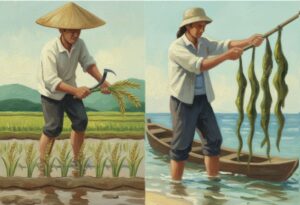The Weather-Rice-Nutrient Integrated Decision Support System (WeRise) was applied in different provinces in Indonesia and the Philippines through on-farm experiments where WeRise predictions were tested under actual rainfed conditions. Despite no significant difference in the grain yields of farmers with and without WeRise predictions, the study found that the farmers with WeRise were able to achieve high grain yields by following the sowing dates determined by WeRise before the season.
The rice ecosystems in Southeast Asia consist mainly of irrigated and rainfed lowlands, which account for 45% and 47% of total rice areas, respectively. This implies the essential role of the rainfed rice ecosystem in food security not only in this sub-region but also in other parts of the world.
Productivity in rainfed rice areas is low compared to irrigated rice areas. For example, the average grain yield for rainfed and irrigated rice in Asia is 2.3 tons/hectare (t/ha) and 5 t/ha, respectively. Water supply is the major constraint in rainfed rice production, resulting in water stress during critical rice growth stages within the cropping season and consequently yield reductions.
Drought is the most devastating abiotic stress. It reduces rice yield significantly when it occurs during a crucial growth stage, especially at germination. Drought periods result in reduced metabolism of the rice seed and germination rate as well as poor seeding quality. Drought damage that occurs at the seedling stage is devastating for the later growth stages. Thus, it should be avoided to obtain a higher yield. Therefore, sowing times need to be optimized to avoid devastating damage from drought and to ensure that the rice plant grows under suitable local weather conditions.
Sowing before or after the optimum time results in exposure to abiotic stresses, poor germination and establishment, and increased risks of soil-borne or seedling diseases. Optimum timing is crucial to obtain higher grain yield, but rainfed rice farmers choose different sowing times based on their past experiences or decisions that could result to low yields. Seasonal climate predictions can improve this situation by enabling adequate lead time to minimize the impact of extreme weather events such as drought.
The WeRise was developed by the International Rice Research Institute (IRRI)-Japan collaborative research projects on Climate Change Adaptation for Rainfed Rice Areas and Climate Change Adaptation through Development of a Decision-Support tool to guide Rainfed Rice production, with funding from the Ministry of Agriculture, Forestry and Fisheries of Japan.
WeRise integrates ORYZA, an eco-physiological crop growth model, with seasonal climate predictions from the Scale Interaction Experiment-Frontier Research Center for Global Change (SINTEX-F). SINTEX-F simulates the climatology and El Niño Southern Oscillation through a relatively high-resolution ocean-atmosphere coupled general circulation model. In a previous study, an appraisal of rainfed rice production was conducted in Indonesia. It identified the causes of problems in rainfed rice farming and confirmed the relevance of the application of seasonal climate predictions.
SINTEX-F demonstrated higher skill in predicting drought years, and thus WeRise showed its potential to reduce risks in rainfed rice production by providing optimum sowing timings for small-scale rice farmers in Indonesia to cope with uncertainties. However, the research results of this study have geographical and genotypic limitations. The applicability of WeRise in more locations and varieties should be tested for wider dissemination.
This study aims to assess the applicability of WeRise for rainfed rice production by evaluating its prediction skill (accuracy) in more locations and rice varieties.
WeRise was applied in different provinces in Indonesia and the Philippines through on-farm experiments where WeRise predictions were tested under actual rainfed conditions. Despite no significant difference in the grain yields of farmers with and without WeRise predictions, the study found that the farmers with WeRise were able to achieve high grain yields by following the sowing dates determined by WeRise before the season.
This implies the possibility of narrowing down the sowing window of the local farmers to allow them to be more strategic in rice production and to manage their resources more efficiently, including their time and labor during the cropping season. The study also demonstrated an improvement in the recovery rate of applied fertilizer through better partial factor productivity. This implies an advantage for rainfed rice farmers in fertilizer application under rainfed conditions.
The obtained results and information showed better probability to improve rainfed rice production in SEA through WeRise. Further verification of its applicability in more SEA countries and regions is recommended to increase the robustness ofWeRise as a game changer for rainfed rice production.
Read the study:
Hayashi K, Llorca LP, Bugayong ID, Agustiani N, Capistrano AOV. (2021) Evaluating the Predictive Accuracy of the Weather-Rice-Nutrient Integrated Decision Support System (WeRise) to Improve Rainfed Rice Productivity in Southeast Asia. Agriculture.11(4):346.






